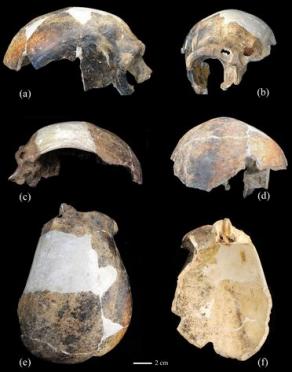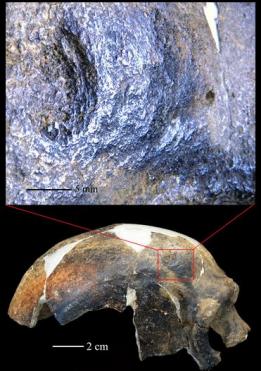Evidence Suggests Violent Interhuman Encounter May Have Occurred 126,000 Years Ago
Source - http://popular-archaeology.com/issue/september-2011/article/evidence-suggests-violent-inter-human-encounter-may-have-occurred-126-000-years-ago
Middle Pleistocene period human cranium shows evidence of having been struck by a blunt instrument, concludes a research study.
Analysis of an archaic human cranium dated to the Middle Pleistocene period and found in China shows evidence that violent human interaction and trauma occurred there about 126,000 years ago.
The cranium, known as the "Maba" cranium, was discovered along with remains of other mammals in 1958 while farmers were removing sediments for fertilizer from a cave at Lion Rock in Guangdong province.
It was analysed by researchers using stereomicroscopy and a high-resolution CT scanner, enabling them to examine the cranium's inner bone structure. This verified that healing had occurred in the ancient wound, confirming that whatever incident had occurred to produce the damage did not lead to immediate death.
Says Prof. Lynne Schepartz from the School of Anatomical Sciences at the University of the Witwatersrand, one of the co-authors of the study report, "This wound is very similar to what is observed today when someone is struck forcibly with a heavy blunt object. As such it joins a small sample of Ice Age humans with probable evidence of humanly induced trauma, and could possibly be the oldest example of interhuman aggression and human induced trauma documented. Its remodelled, healed condition also indicates the survival of a serious brain injury, a circumstance that is increasingly documented for archaic and modern Homo through the Pleistocene."
Schepartz indicated that it was not possible from this study to determine with certainty if the wound was the result of interhuman aggression or an accidental incident, although it does shed more light on "the abilities of Pleistocene humans to survive serious injury and post-traumatic disabilities. Maba would have needed social support and help in terms of care and feeding to recover from this wound."

This is the reconstructed Maba 1 cranium (A) Right lateral view (B) anterior view (C) left lateral view (D) posterior view (E) superior view (F) basal view. Credit: University of the Witwatersrand

This is the right superolateral view of the Maba cranium showing the position (A) and detail (B) of the depressed lesion. Credit: University of the Witwatersrand

These are CT reconstructions depicting the lesion on the Maba cranium. Credit: University of the Witwatersrand
The detailed report is published in the November 21, 2011, edition of the Proceedings of the National Academy of Sciences.
Co-authors of the report are Xiu-Jie Wu and Wu Liu of the Institute of Vertebrate Paleontology and Paleoanthropology at the Chinese Academy of Sciences, Beijing, China and Erik Trinkaus from the Department of Anthropology, Washington University, St. Louis.